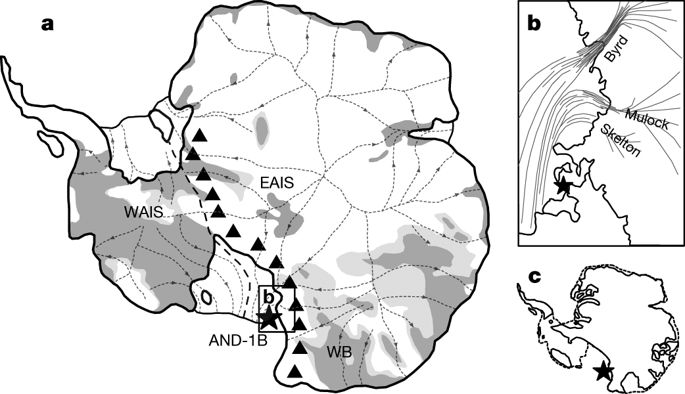Our official English website, www.x-mol.net, welcomes your
feedback! (Note: you will need to create a separate account there.)
Minimal East Antarctic Ice Sheet retreat onto land during the past eight million years
Nature ( IF 50.5 ) Pub Date : 2018-06-01 , DOI: 10.1038/s41586-018-0155-6 Jeremy D. Shakun , Lee B. Corbett , Paul R. Bierman , Kristen Underwood , Donna M. Rizzo , Susan R. Zimmerman , Marc W. Caffee , Tim Naish , Nicholas R. Golledge , Carling C. Hay
Nature ( IF 50.5 ) Pub Date : 2018-06-01 , DOI: 10.1038/s41586-018-0155-6 Jeremy D. Shakun , Lee B. Corbett , Paul R. Bierman , Kristen Underwood , Donna M. Rizzo , Susan R. Zimmerman , Marc W. Caffee , Tim Naish , Nicholas R. Golledge , Carling C. Hay

|
The East Antarctic Ice Sheet (EAIS) is the largest potential contributor to sea-level rise. However, efforts to predict the future evolution of the EAIS are hindered by uncertainty in how it responded to past warm periods, for example, during the Pliocene epoch (5.3 to 2.6 million years ago), when atmospheric carbon dioxide concentrations were last higher than 400 parts per million. Geological evidence indicates that some marine-based portions of the EAIS and the West Antarctic Ice Sheet retreated during parts of the Pliocene1,2, but it remains unclear whether ice grounded above sea level also experienced retreat. This uncertainty persists because global sea-level estimates for the Pliocene have large uncertainties and cannot be used to rule out substantial terrestrial ice loss3, and also because direct geological evidence bearing on past ice retreat on land is lacking. Here we show that land-based sectors of the EAIS that drain into the Ross Sea have been stable throughout the past eight million years. We base this conclusion on the extremely low concentrations of cosmogenic 10Be and 26Al isotopes found in quartz sand extracted from a land-proximal marine sediment core. This sediment had been eroded from the continent, and its low levels of cosmogenic nuclides indicate that it experienced only minimal exposure to cosmic radiation, suggesting that the sediment source regions were covered in ice. These findings indicate that atmospheric warming during the past eight million years was insufficient to cause widespread or long-lasting meltback of the EAIS margin onto land. We suggest that variations in Antarctic ice volume in response to the range of global temperatures experienced over this period—up to 2–3 degrees Celsius above preindustrial temperatures4, corresponding to future scenarios involving carbon dioxide concentrations of between 400 and 500 parts per million—were instead driven mostly by the retreat of marine ice margins, in agreement with the latest models5,6.Analysis of cosmogenic isotopes from a marine sediment core shows that much of the land-based East Antarctic Ice Sheet has remained stable for the past eight million years, including during the warm Pliocene epoch.
中文翻译:

在过去的八百万年里,南极东部冰盖最少退缩到陆地上
南极东部冰盖 (EAIS) 是导致海平面上升的最大潜在因素。然而,预测 EAIS 未来演变的努力受到它如何应对过去温暖时期的不确定性的阻碍,例如,在上新世时期(5.3 至 260 万年前),当时大气二氧化碳浓度最后高于 400百万分之一。地质证据表明,EAIS 的一些海洋部分和南极西部冰盖在上新世的部分地区退缩,但尚不清楚海平面以上的冰是否也经历了退缩。这种不确定性持续存在,因为对上新世的全球海平面估计具有很大的不确定性,不能用来排除大量的陆地冰损失3,也因为缺乏与过去陆地上的冰层退缩有关的直接地质证据。在这里,我们展示了流入罗斯海的 EAIS 陆基部分在过去 800 万年中一直保持稳定。我们的这一结论基于在从近陆海洋沉积物岩心提取的石英砂中发现的极低浓度的宇宙成因 10Be 和 26Al 同位素。这些沉积物已从大陆上被侵蚀,其低水平的宇宙核素表明它只经历了极少的宇宙辐射暴露,这表明沉积物来源区域被冰覆盖。这些发现表明,过去 800 万年的大气变暖不足以导致 EAIS 边缘大范围或持久地回滚到陆地上。
更新日期:2018-06-01
中文翻译:

在过去的八百万年里,南极东部冰盖最少退缩到陆地上
南极东部冰盖 (EAIS) 是导致海平面上升的最大潜在因素。然而,预测 EAIS 未来演变的努力受到它如何应对过去温暖时期的不确定性的阻碍,例如,在上新世时期(5.3 至 260 万年前),当时大气二氧化碳浓度最后高于 400百万分之一。地质证据表明,EAIS 的一些海洋部分和南极西部冰盖在上新世的部分地区退缩,但尚不清楚海平面以上的冰是否也经历了退缩。这种不确定性持续存在,因为对上新世的全球海平面估计具有很大的不确定性,不能用来排除大量的陆地冰损失3,也因为缺乏与过去陆地上的冰层退缩有关的直接地质证据。在这里,我们展示了流入罗斯海的 EAIS 陆基部分在过去 800 万年中一直保持稳定。我们的这一结论基于在从近陆海洋沉积物岩心提取的石英砂中发现的极低浓度的宇宙成因 10Be 和 26Al 同位素。这些沉积物已从大陆上被侵蚀,其低水平的宇宙核素表明它只经历了极少的宇宙辐射暴露,这表明沉积物来源区域被冰覆盖。这些发现表明,过去 800 万年的大气变暖不足以导致 EAIS 边缘大范围或持久地回滚到陆地上。











































 京公网安备 11010802027423号
京公网安备 11010802027423号